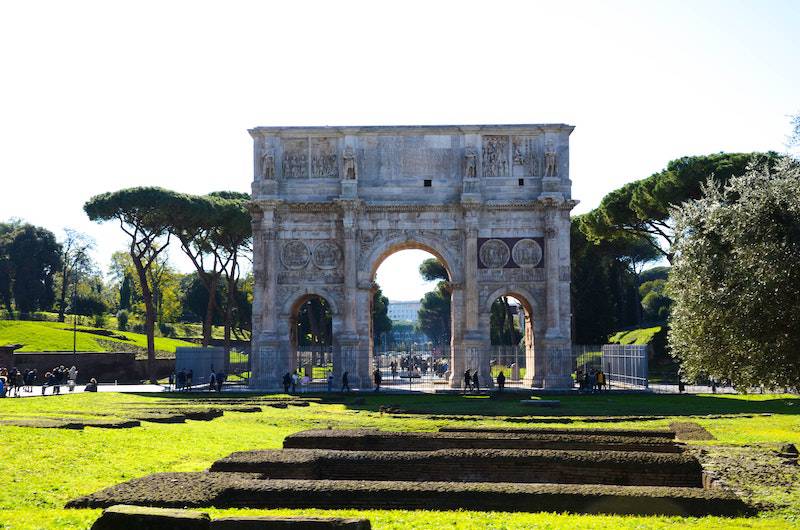The area around the Colosseum is rich in monuments and places that absolutely deserve a visit. Therefore, limiting oneself to a quick glance at the exterior of the Flavian Amphitheater and then heading inside the arena would not do justice to an area, that of the Archaeological Park of the Colosseum, which is much larger and more fascinating.
Among the monuments that are undoubtedly worth admiring is the Arch of Constantine. Located right next to the Flavian Amphitheater, at 25 meters, it is the largest of the three triumphal arches still present in Rome (the other two are located within the Roman Forum and are the Arches of Titus and Septimius Severus).
Construction of the Arch of Constantine
The arch was erected in 315 to celebrate the victory of Emperor Constantine over Maxentius, which occurred on October 28, 312 AD in the Battle of the Milvian Bridge. It was erected on the ancient Triumphal Way, reusing partially the materials and architectural elements of older imperial monuments (Trajan, Hadrian, and Commodus). This was the first episode of a sad custom that would last throughout the Middle Ages: that of reusing materials from older monuments. Such a choice also reflects what Rome had become at that historical period, far from the glories of the past, no longer as powerful as before, and lacking skilled sculptors to adorn the monument dedicated to Constantine.
The arch has three archways: the central one, which is also the widest, bears relief decoration on all sides, while in the minor arches, the deeds of Constantine in the campaign against Maxentius are narrated. The upper part is occupied by eight statues of Dacians, from the Forum of Trajan, a long inscription, and large panels from the time of Marcus Aurelius, depicting episodes related to the Germanic war. It has come down to us substantially intact also thanks to some significant integrative interventions completed in 1733, which involved the integration of missing parts after Lorenzino the Magnificent had cut off the heads on the reliefs of the arch for amusement in 1530. It was only in 1832 that the Arch of Constantine was arranged as we see it today, carried out in 1832, thanks to the enlargement works of Via di San Gregorio carried out by Pope Gregory XVI, renamed during the fascist regime Via dei Trionfi.
The Historic Inscription
Among the most peculiar elements of the Arch of Constantine, there is certainly the inscription placed in the center of the entablature:
“imp(eratori) caes(ari) f(lavio) constantino maximo p(io) f(elici) augusto s(enatus) p(opulus) q(ue) r(omanus) quod instinctu divinitatis mentis magnitudine cum exercitu suo tam de tyranno quam de omni eius factione uno tempore iustis rem publicam ultus est armis arcum triumphis insignem dicavit”
Which means: “To the Emperor Caesar Flavius Constantinus, the greatest, pious, fortunate, Augustus, the Senate and the Roman People, because by inspiration of divinity and by greatness of mind, he with his army avenged the State at the same time against a tyrant and all his faction with just arms, dedicated this remarkable arch for triumphs.”
Interpretation and Significance
The phrase “instinctu divinitatis” (“by inspiration of divinity”) has been interpreted by many scholars as proof of Constantine’s conversion to Christianity during the battle, also following the vision of the cross in the sky associated with the inscription “in hoc signo vinces” (in this sign, you will conquer), after which Constantine and Licinius decreed freedom of worship throughout the Empire, thus favoring the spread of Christianity.
Plan Your Visit to the Arch of Constantine
If you have already planned a tour to discover the secrets of the most important amphitheater in the world and the nearby Basilica of San Clemente, an intermediate stop to admire this Arch that tells the marvelous deeds of one of the emperors who made the history of ancient Rome.


